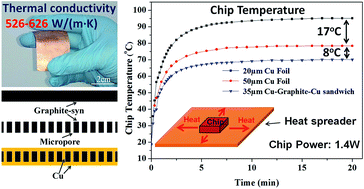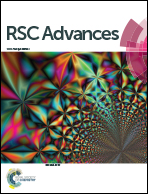Copper–graphite–copper sandwich: superior heat spreader with excellent heat-dissipation ability and good weldability
Abstract
The thermal management of smart and wearable electronics has become a serious issue, due to their reducing size and increasing power density, which has high requirement on weight, size and thermal conductance. In this paper, we propose an effective approach to fabricate Cu–graphite–Cu (Cu–G–Cu) sandwich heat spreaders by electroplating Cu on synthetic graphite sheets. The binding between Cu layers and graphite-syn sheets was largely improved by the fastening of microholes. We demonstrate experimentally that the obtained Cu–G–Cu heat spreaders with higher thermal conductance (526–626 W (m K)−1) and thermal diffusivity (319–442 mm2 s−1) and lower density (2.36–3.17 g cm−3) present outstanding ability of heat dissipation on electronic cooling as compared with Cu substrates. The temperature of a chip attached to a 35 μm Cu–G–Cu sandwich was ∼8 °C lower than that on 50 μm Cu foil with the chip power of 1.4 W. Moreover, Ansys simulation illustrates that the temperature of the chip attached to the Cu–G–Cu sandwich with Sn solder as the thermal interface material (TIM) can be further reduced by 22.06 ± 9.88 °C (3.0 W) compared with that with polymer adhesive as a TIM, due to its good weldability with Sn solder and lower contact thermal resistance, revealing the huge benefits of the obtained Cu–G–Cu sandwich heat spreaders.


 Please wait while we load your content...
Please wait while we load your content...